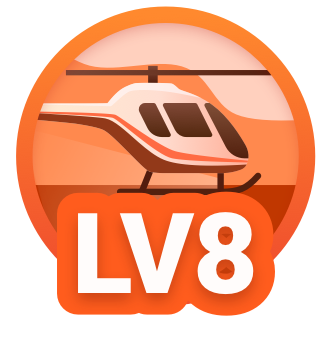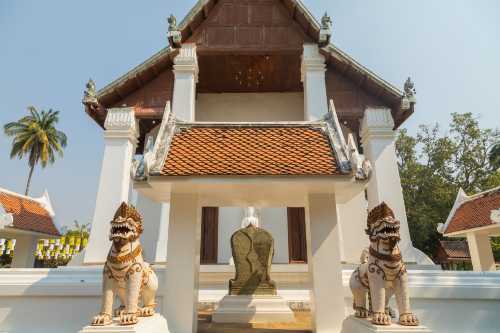App
Customer Support
Find Bookings
#GetDiscountsWithoutLuck #VisitSukhothai #ThaiTemple #BeautifulTemple #SililTrip "GivingAlmsToTheBlessingsAtTheSunSukhothaiBlessingSanBuri" Everyday at six in the morning, tourists can wait to give alms on the bridge. They can buy alms sets in front of the temple. Monks will walk to receive alms on the bridge in front of Wat Trapangthong. "Wat Trapangthong" is an ancient temple built during the reign of King Ramkhamhaeng the Great. Tourists can worship the sacred objects and admire the beauty of the interesting ancient architecture located on an island in the middle of a pond called "Trapangthong". There is a bell-shaped main stupa made of laterite as the base. In front, there is a white church standing tall in the middle of the water. There is a bridge across the pond on all three sides. Walk out of the chapel to the back and you will find a small white four-sided pavilion located on the same level as the chapel and the stupa. It is the place where the footprints of the Lord Buddha with 108 auspiciousness are enshrined. Walk to the south of the island. Here, there will be a statue of Phra Ruang, who was ordained as a monk, standing holding a broom and talking to the Khmers. Which protrudes from the ground, is the origin of the word "Khom Dam Din". The area around the temple is a beautiful and shady area and there is also fish food for sale for making merit in the temple area. It is considered that visiting once can make merit in a complete way, including giving alms, making merit, giving donations to fish, and worshiping Buddha. It is considered another place that should not be missed when visiting Sukhothai. Location: Tambon Muang Kao, Amphoe Mueang Sukhothai, Sukhothai 🕰️ Opening hours: Open every day
Slinslin
Ancient temple in the middle of a pond, Sukhothai province Wat Trapang Thong is located within the walls of Sukhothai city or to the east of the Ramkhamhaeng National Museum, Sukhothai. It is an ancient site located on an island in the middle of a pond called Trapang Thong. There is a main chedi in the shape of a bell, made of laterite as the base, while the upper part is made of bricks. Around the main chedi are 8 surrounding chedis. As for the chapel (the church), whose walls and roof are still quite intact, this is because about 100 years ago, Phraya Ronachai Chanyut (Garuda), the governor of Sukhothai, came to ordain as a novice and collected money to build the chapel. In 2005, the chapel was renovated again. An important thing about this temple is the footprint of the Buddha from the Sukhothai period, carved with 108 auspicious patterns. This footprint was moved from Khao Phra Bat Yai. Which Phra Maha Thammaracha Lithai built and enshrined at Khao Sumanakut in 1902 #VisitHistoricalSite #Mr.Tourist
นายท่องเที่ยว
#Get a discount without relying on luck# Wat Sri Sawai is located about 350 meters south of Wat Mahathat. This important ancient site is located in the glass wall. It consists of three prangs in the Lopburi art style. The prangs are quite slender and located on a low base. Some of the stucco patterns resemble those on Chinese porcelain. During the Yuan Dynasty, a lintel carved with the image of Narayana reclining on the ocean was found, parts of idols, and a lingam, showing that it was once a Hindu temple. It was then converted into a Buddhist temple by adding a chapel at the front, and later became a Buddhist temple. Wat Sri Sawai was originally a Brahman or Hindu temple. It is a three-tiered Khmer prang with a moat surrounding the three prangs. This ancient site originated from the Khmer castle style, but it has been modified from the original, for example, the decorative parts of the Khmer castle called banthaeng have become jackfruit petals, and the stucco decorated with jackfruit petals in the shape of Garuda fighting the naga and angels. The prang of Wat Sri Sawai is therefore different from the prangs of the Ayutthaya period, which are prototyped from. The prang in Khmer art is more similar to the Khmer style than the prang in the Sukhothai style.
เปรมยุ
#GetDiscountNotDependingOnLuck#WatMahathat is the largest temple in the city. It was built in the 18th Buddhist century or the early Sukhothai period. In the stone inscription of King Ramkhamhaeng of 1835 B.E. (Pillar 1, Side 2, Lines 23–26), it is mentioned that "In the middle of Sukhothai city, there is a viharn, there is a Buddha statue", which means the royal temple on the east side of the main chedi used to be the place where a Sukhothai-style bronze Buddha statue was enshrined, 6.25 meters wide at the lap. Phra Maha Thammaracha Lithai ordered it to be cast and celebrated in 1904 B.E. WatMahathat also has important components, namely the Mahathat Chedi and 8 surrounding prang-shaped chedis, which act as chedis for each side (direction). They are influenced by Khmer art and have stucco patterns influenced by Sri Lankan art. The chedis at the four corners are five-spire castle-shaped chedis influenced by Bagan-Hariphunchai-Lanna art. They are considered one of the most complete examples of authentic Sukhothai castle-style chedis left in the world. Wat Mahathat was announced as an ancient monument in the Royal Gazette Volume 52, Part 75, dated March 8, 1935. The ancient monument group, the area of the temple is 200 meters wide and long on each side. There is a Mahathat pagoda in the shape of a lotus bud or a rice bundle as the main landmark of the temple. Inside, there are various types of pagodas, bases of the temple, bases of the chapel, and niches for Buddha images, consisting of: Mahathat pagoda is the main pagoda in the middle of the temple. It is shaped like a lotus bud or a rice bundle. It is located on a three-tiered sky level. Around the base of the lowest level are stucco sculptures of disciples walking with hands together. The size of the pagoda base is 27 meters wide and 29 meters high on the same base. There are 4 prangs in front of the pagoda in all 4 directions. At the corners of the four directions, there are 4 pagodas in the Srivijaya and Sri Lankan castle styles, located as subsidiary pagodas of the main pagoda. There are 200 minor pagodas. The bases of the temple are of 10 different sizes, including the Phra Sri Sakyamuni shrine. Located in front or east of the Phra Mahathat Chedi, 8 niches, the base of the chapel, located on the north side of the Phra Mahathat Chedi, 14 meters wide, 25 meters long, made of bricks, 4 ponds located on the north and west sides, and a glass wall made of bricks surrounding the temple area on all 4 sides, 200 meters wide and long on each side.
เปรมยุ
#GetDiscountNotDependingOnLuck Wat Sri Chum is an ancient religious site located outside the northern city wall of Sukhothai Historical Park, Muang Kao Subdistrict, Mueang Sukhothai District, Sukhothai Province. This temple enshrines a large Buddha statue in the Mara-Vijaya posture called "Phra Atchana". The Buddha statue is enshrined in a pavilion, which has now collapsed, leaving only the surrounding walls, making it an outdoor Buddha statue to this day. The structure of Wat Sri Chum is more special than other temples in Sukhothai Historical Park because it does not have a main chedi, but is replaced by a pavilion enshrining a Buddha statue inside, which is located behind the main chapel. This temple is believed to have been built during the reign of King Ramkhamhaeng the Great, or around the 19th Buddhist century. It was first restored by the Fine Arts Department in 1953 and the pavilion area was restored again in 1967. Phra Phuttha Atchana is considered one of the most important tourist attractions and symbols of Sukhothai Historical Park. In addition, the area on the northern side of the pavilion also consists of a large wild mango tree that is more than 200 years old, with a height of more than 20 meters. It has been preserved and registered as a national heritage by the Ministry of Culture. "Wat Sri Chum" comes from the original local word meaning Bodhi tree. Therefore, the name Sri Chum means a grove of Bodhi trees. However, in the book of the Royal Chronicles of Ayutthaya written in the late Ayutthaya period, this meaning was not understood, so the place was called "Rishi Chum". Wat Sri Chum is assumed to have been built during the reign of King Ramkhamhaeng, as stated in the Sukhothai Inscription No. 1 that At the foot of the bed of Sukhothai city... there is Phra Achana, there is a castle. The principal Buddha image in the pavilion is therefore called "Phra Achana". The pavilion is 32 meters wide on each side, 15 meters high, and the walls are 3 meters thick. The left wall has a hole for a staircase. The wall leads to the roof. There are old paintings on the walls of the tunnel, but almost all of them are faded. This painting is almost 700 years old. The ceiling and walls have 50 slate slabs carved with lines depicting stories from various Jatakas, arranged continuously. All of these are considered to be the oldest Thai paintings. During the Ayutthaya period, when Somdet Phra Naresuan the Great declared independence in 2127 at the city of Kraeng, causing other cities to cancel their tributes to the Burmese, but there was still the city of Cheliang (Sawankhalok) that refused to comply with his royal command. So he led his army to conquer Cheliang and gathered his army at Wat Sri Chum before going to attack Cheliang. Since the battle was between Thais and other Thais, the soldiers were not motivated to fight. Somdet Phra Naresuan therefore planned to boost the soldiers’ morale by having one of his soldiers climb up the stairs behind the Buddha image and speak words of encouragement to them, which gave the soldiers the motivation to fight. As a result, the legend of the talking Buddha at Wat Sri Chum arose. Phra Naresuan also held the water-pouring ceremony to pledge allegiance at this temple. According to evidence, this temple was extensively renovated during the reign of King Lithai and has been continuously maintained. It is assumed that this temple was abandoned during the late Ayutthaya period until the reign of King Rama IX when a renovation project was launched in 1952. The restoration of the Phra Achana Buddha image was initiated by Professor Silpa Bhirasri and Professor Khian Yimsiri. As a result, the temple is in its current state. "Phra Achana" The word Achana has been interpreted as referring to the Pali word "Ajala", which means "one who is unshakable, steadfast", "one who is worthy of respect and worship". Phra Achana is a Buddha image in the Mara-Vijaya attitude, sitting cross-legged. The material is stucco, the inner core is made of brick and laterite. The lap is 11.30 meters wide and 15 meters high. The Buddha image is large and fills the entire temple. It is in the Sukhothai style.
เปรมยุ
#GetDiscountsWithoutLuck#VisitSukhothai #MustVisitCafe #SililTrip #CafeWithRelaxingAtmosphere The owner of Makhuwit House told us that he was inspired by King Rama IX who taught about sufficiency economy and mixed farming. This led to the idea of making a small accommodation and coffee shop, as well as a souvenir shop made by locals, all in one place at Makhuwit House. Makhuwit House is a small accommodation and cafe located in a dynamic rice field. In front of the house or almost in the middle of the land, there is a Makhuwit tree. The area inside the house is divided into accommodation and a restaurant, decorated in a unique and beautiful style. Every corner of the shop is beautifully decorated, shady, and has a semi-contemporary Thai style. There are many photo spots, and outside there is a view of the green rice fields as far as the eye can see. The price of the drinks is not expensive and the taste is good. It is suitable for meeting a group of friends to sit and relax, talk, and eat comfortably. It is another beautiful shop that you must not miss if you come to Sukhothai. Location: Tambon Mueang Sukhothai District, Sukhothai Province 🕰️Opening hours: Open daily from 10:00 a.m. to 4:00 p.m.
Slinslin
Popular Trip Moments
Luxury resort where architectural beauty harmonizes with deep nature | Recommended for a "Journey of the Heart" in Thailand! | A peaceful UNESCO 📍sukhothai | BAAN MA-KWID Sukhothai | Ban Na Ton Chan: The Charm of Rural Life Amidst the Mountains | 🧋The Nature | ☕ The Nature | 🌅 Give alms to monks on the bridge of merit, welcome the Sukhothai dawn at Wat Trapang Thong. | Visit "Sukhothai Historical Park" | Review of Wat Si Chum, Sukhothai - A must-visit destination in your lifetime! | Twilight Alchemy: Sunsets over the Sukhothai Historical Park | Agape Coffee Agape Sukhothai | Uncle Joy's Shop, Sukhothai | 💢 Thinking of taking a break? Think of Sabai Dee House Sukhothai. | The Nature Cafe | Sweet Rice Cafe @Sukhothai | Thailand's oldest city, Sukhothai. | 📌 Wat Chang Lom, Sukhothai Historical Park | The Nature Cafe | Midtown Sukhothai Resort | 📍Thailand. Sukhothai Historical Park|West District Saphan Hin Temple Stone Bridge Temple
Recommended Attractions at Popular Destinations
Popular Attractions in Bangkok | Popular Attractions in Manila | Popular Attractions in Tokyo | Popular Attractions in Taipei | Popular Attractions in Hong Kong | Popular Attractions in Seoul | Popular Attractions in Kuala Lumpur | Popular Attractions in Los Angeles | Popular Attractions in Shanghai | Popular Attractions in New York | Popular Attractions in Shenzhen | Popular Attractions in Osaka | Popular Attractions in Singapore | Popular Attractions in London | Popular Attractions in Guangzhou | Popular Attractions in San Francisco | Popular Attractions in Beijing | Popular Attractions in Macau | Popular Attractions in Bali | Popular Attractions in Jakarta | Popular Attractions in Paris | Popular Attractions in Ho Chi Minh City | Popular Attractions in Istanbul | Popular Attractions in Phuket | Popular Attractions in Chicago | Popular Attractions in Seattle | Popular Attractions in Toronto | Popular Attractions in Orlando | Popular Attractions in Cebu | Popular Attractions in Chiang Mai
Popular Restaurants in Sukhothai
Baan Junshine | Poo Restaurant | Bike Mania Beer Room | Dream Cafe | Artitaya Restaurant | Nham Khang Sukhothai Restaurant | An-Guy Coffee | Thara Restaurant | The Alibaba Indian Food | Maeboonmee | MAI PRA DIT Coffee and Bistro | Old City Landmark Cafe | Sukhotai Seafood | Sabaidee Guesthouse | Mai Krang Krung | Felice' | Mangkon Khap Kaew | Mrs.Ann Bakery & Coffee | 379 Drip | Black Sugar | Coffee House | Bami Meng | Kacha | Say Hi Cafe | Foresto Restaurant | Kacha Cafe & Restaurant | Pa Ouan Moo Jum | Kaeng Sak | The Coffee Cup | Ploy Chompu Kitchen
Popular Ranked Lists
Top 10 Trending Attractions in Qinhuangdao | Top 50 Must-Visit Restaurants in Xi'an | Popular Trending Attractions in Singapore | Top 50 Must-Visit Restaurants in Munich | Popular Trending Attractions in Shenyang | Popular Premium Hotels in Emirate of Sharjah | Top 50 Must-Visit Restaurants in Hong Kong | Popular Premium Hotels in Castries | Popular Trending Attractions in Dunhuang | Popular Trending Attractions in Tonglu | Top 50 Must-Visit Restaurants in Barcelona | Popular Trending Attractions in Changzhou | Popular Trending Attractions in Sanya | Top 50 Must-Visit Restaurants in Madrid | Top 10 Trending Attractions in Tokyo | Popular Premium Hotels in Extremadura | Top 50 Must-Visit Restaurants in Dalat | Popular Premium Hotels in Canton of St. Gallen | Top 10 Trending Attractions in Kyoto | Popular Premium Hotels in Mubarak Al-Kabeer Governorate | Top 50 Must-Visit Restaurants in Hanoi | Popular Premium Hotels in Ica | Top 50 Must-Visit Restaurants in Ho Chi Minh City | Popular Premium Hotels in Bay of Plenty | Top 10 Trending Attractions in Wuhan | Popular Premium Hotels in Navarre | Popular Premium Hotels in County Kilkenny | Top 20 Premium Hotels in Eastern Province | Popular Premium Hotels in Vastmanland | Top 10 Trending Attractions in Guangzhou
About
Payment Methods
Our Partners
Copyright © 2025 Trip.com Travel Singapore Pte. Ltd. All rights reserved
Site Operator: Trip.com Travel Singapore Pte. Ltd.
Site Operator: Trip.com Travel Singapore Pte. Ltd.





















